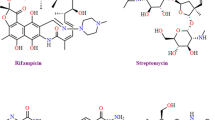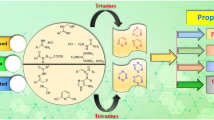Abstract
A benzimidazolydine-based novel ligand L2 was prepared from 1,2-bis(benzimidazol-1-yl)ethane (L1) and synthesis of metallocycle complexes such as Ag(I)–N-Heterocyclic Carbene abbreviated as Ag–NHC and Cu(I)–N-Heterocyclic Carbene complex as Cu–NHC were synthesized and then estimated for antimicrobial and antioxidant properties. Synthesis of Ag–NHC and Cu–NHC metallocycle complexes was described. The benzimidazolydine ligand precursor and its Ag–NHC and Cu–NHC were successfully characterized by FT-IR, FT-Raman, 1D and 2D NMR, HR-ESI mass spectra, and cyclic voltammetric studies. In the present work, antimicrobial study discloses that ligand (L1 and L2) do not show inhibitory activity against various pathogens; however, it was gradually increased, when they were coordinated to metals like Ag and Cu. Among the four compounds, the Ag–NHC strongly hampers the growth of fungal strains. The minimal inhibitory concentration (MIC) ranged between 46 and 750 μg mL−1. A distinctive cell growth reduction was observed in C. albicans when treated with minimum concentration of Ag–NHC complex. Ag–NHC exhibited the ability to prevent the growth of C. albicans by causing severe membrane damage and accumulation of intracellular reactive oxygen species (ROS), which were revealed by fluorescence spectroscopic studies. The tested (L1, L2, Ag–NHC and Cu–NHC) compounds demonstrated significant activity with IC50 values range (0.20–30 μM) for DPPH, OH and NO antioxidant activity. Ascorbic acid was used as standard drug. The radical scavenging potencies of the compounds were explored by employing DPPH, OH and NO assays, in which Ag–NHC exhibited highest inhibitory effect on the radicals [IC50 = 57.3 μM (DPPH), 57.7 μM (OH), 52.3 μM (NO)].











Similar content being viewed by others
References
Abdal Dayem A et al (2017) The role of reactive oxygen species (ROS) in the biological activities of metallic nanoparticles. Int J Mol Sci 18(1):120. https://doi.org/10.3390/ijms18010120
Aher S et al (2017) Synthesis, characterization and antimicrobial properties of methylbenzyl and nitrobenzyl containing imidazolium-based silver N-heterocyclic carbenes. J Mol Liq 233:270–277. https://doi.org/10.1016/j.molliq.2017.03.021
Akhtar W et al (2017) Therapeutic evolution of benzimidazole derivatives in the last quinquennial period. Eur J Med Chem 126:705–753. https://doi.org/10.1016/j.ejmech.2016.12.010
Andrés MT, Viejo-Díaz M, Fierro JF (2008) Human lactoferrin induces apoptosis-like cell death in Candida albicans: critical role of K + -channel-mediated K + efflux. Antimicrob Agents 52(11):4081–4088. https://doi.org/10.1128/AAC.01597-07
Arjmand F, Mohani B, Ahmad S (2005) Synthesis, antibacterial, antifungal activity and interaction of CT-DNA with a new benzimidazole derived Cu (II) complex. Eur J Med Chem 40(11):1103–1110. https://doi.org/10.1016/j.ejmech.2005.05.005
Babizhayev MA et al (1998) Design and biological activity of imidazole-containing peptidomimetics with a broad-spectrum antioxidant activity. Lett Pept Sci 5(2-3):163–169. https://doi.org/10.1007/BF02443462
Banerjee A et al (2014) The DNA intercalators ethidium bromide and propidium iodide also bind to core histones. FEBS Open Biol 4(1):251–259. https://doi.org/10.1016/j.fob.2014.02.006
Barnard PJ, Berners-Price SJ (2007) Targeting the mitochondrial cell death pathway with gold compounds. Coord Chem Rev 251(13-14):1889–1902. https://doi.org/10.1016/j.ccr.2007.04.006
Bellemin-Laponnaz S, Dagorne S (2014) Group 1 and 2 and early transition metal complexes bearing N-heterocyclic carbene ligands: coordination chemistry, reactivity, and applications. Chem Rev 114(18):8747–8774. https://doi.org/10.1021/cr500227y
Benaroudj N, Lee DH, Goldberg AL (2001) Trehalose accumulation during cellular stress protects cells and cellular proteins from damage by oxygen radicals. J Biol Chem 276(26):24261–24267. https://doi.org/10.1074/jbc.M101487200
Benhamou L et al (2011) Synthetic routes to N-heterocyclic carbene precursors. Chem Rev 111(4):2705–2733. https://doi.org/10.1021/cr100328e
Borkow G, Gabbay J (2005) Copper as a biocidal tool. Curr Med Chem 12(18):2163–2175. https://doi.org/10.2174/0929867054637617
Busetto L et al (2008) Synthesis, molecular structures and solution NMR studies of N-heterocyclic carbene–amine silver complexes. J Organomet Chem 693(15):2579–2591. https://doi.org/10.1016/j.jorganchem.2008.04.030
Charra V, de Frémont P, Braunstein P (2017) Multidentate N-heterocyclic carbene complexes of the 3d metals: synthesis, structure, reactivity and catalysis. Coord Chem Rev 341:53–176. https://doi.org/10.1016/j.ccr.2017.03.007
Cole ER, Crank G, Salam-Sheikh A (1974) Antioxidant properties of benzimidazoles. J Agric Food Chem 22(5):918. https://doi.org/10.1021/jf60195a022
De Frémont P, Marion N, Nolan SP (2009) Carbenes: synthesis, properties, and organometallic chemistry. Coord Chem Rev 253(7-8):862–892. https://doi.org/10.1016/j.ccr.2008.05.018
Gaetke LM, Chow-Johnson HS, Chow CK (2014) Copper: toxicological relevance and mechanisms. Arch Toxicol 88(11):1929–1938. https://doi.org/10.1007/s00204-014-1355-y
Garrison JC, Youngs WJ (2005) Ag (I) N-heterocyclic carbene complexes: synthesis, structure, and application. Chem Rev 105(11):3978–4008. https://doi.org/10.1021/cr050004s
GÜLÇin I, Alici HA, Cesur M (2005) Determination of in vitro antioxidant and radical scavenging activities of propofol. Chem Pharm Bull 53(3):281–285. https://doi.org/10.1248/cpb.53.281
Hahn FE et al (2008) A nickel (II)-cornered molecular rectangle with biscarbene and 4, 4′-bipyridine bridging groups. Organometallics 27(24):6408–6410. https://doi.org/10.1021/om801007u
Haque RA et al (2015) Synthesis, crystal structures, characterization and biological studies of nitrile-functionalized silver(I) N-heterocyclic carbene complexes. Inorg Chim Acta 433:35–44. https://doi.org/10.1016/j.ica.2015.04.023
Hindi KM et al (2009) The medicinal applications of imidazolium carbene—metal complexes. Chem Rev 109(8):3859–3884. https://doi.org/10.1021/cr800500u
Hutchinson B, Takemoto J, Nakamoto K (1970) Metal isotope effect on metal-ligand vibrations. II. Tris complexes of 2, 2′-bipyridine and 1, 10-phenanthroline. J Am Chem Soc 92(11):3335–3339. https://doi.org/10.1021/ja00714a017
Hwang IS et al (2012a) Silver nanoparticles induce apoptotic cell death in Candida albicans through the increase of hydroxyl radicals. FEBS J 279(7):1327–1338. https://doi.org/10.1111/j.1742-4658.2012.08527.x
Hwang JH et al (2012b) (+)-Medioresinol leads to intracellular ROS accumulation and mitochondria-mediated apoptotic cell death in Candida albicans. Biochimie 94(8):1784–1793. https://doi.org/10.1016/j.biochi.2012.04.010
Kascatan-Nebioglu A et al (2007) N-heterocyclic carbene–silver complexes: a new class of antibiotics. Coord Chem Rev 251(5-6):884–895. https://doi.org/10.1016/j.ccr.2006.08.019
Kishore R, Das SK (2013) Synthesis, structural characterization and properties of new N-heterocyclic carbene Ag (I) complexes. J Mol Struct 1053:38–47. https://doi.org/10.1016/j.molstruc.2013.08.051
Kohanski MA et al (2007) A common mechanism of cellular death induced by bactericidal antibiotics. Cell 130(5):797–810. https://doi.org/10.1016/j.cell.2007.06.049
Kopel P et al (2015) Biological activity and molecular structures of bis (benzimidazole) and trithiocyanurate complexes. Molecules 20(6):10360–10376. https://doi.org/10.3390/molecules200610360
Krishnamurthy D et al (2008) Gold (I)-mediated inhibition of protein tyrosine phosphatases: a detailed in vitro and cellular study. J Med Chem 51(15):4790–4795. https://doi.org/10.1021/jm800101w
Lewis A et al (2016) The chemical biology of Cu (II) complexes with imidazole or thiazole containing ligands: synthesis, crystal structures and comparative biological activity. J Inorg Biochem 157:52–61. https://doi.org/10.1016/j.jinorgbio.2016.01.014
Lin IJB, Vasam CS (2007) Preparation and application of N-heterocyclic carbene complexes of Ag (I). Coord Chem Rev 251(5-6):642–670. https://doi.org/10.1016/j.ccr.2006.09.004
Madeo F et al (1999) Oxygen stress: a regulator of apoptosis in yeast. J Cell Biol 145(4):757–767
Ou ZB et al (2013) A copper (II) complex with 2-(2′-pyridyl) benzimidazole and l-arginine: synthesis, structure, antibacterial activities, and DNA interaction. J Coord Chem 66(12):2152–2165. https://doi.org/10.1080/00958972.2013.800195
Patil S et al (2011) Synthesis, cytotoxicity and antibacterial studies of novel symmetrically and non-symmetrically p-Nitrobenzyl-Substituted N-Heterocyclic Carbene-Silver(I) Acetate Complexes. Zeitschrift für anorganische und allgemeine Chemie 637(3-4):386–396. https://doi.org/10.1002/zaac.201000395
Percival SL, Bowler PG, Russell D (2005) Bacterial resistance to silver in wound care. J Hosp Infect 60(1):1–7
Prosser KE et al (2017) Anticancer copper pyridine benzimidazole complexes: ROS generation, biomolecule interactions, and cytotoxicity. J Inorg Biochem 167:89–99. https://doi.org/10.1016/j.jinorgbio.2016.11.006
Pugh D, Boyle A, Danopoulos AA (2008) ‘Pincer’pyridine dicarbene complexes of nickel and their derivatives. Unusual ring opening of a coordinated imidazol-2-ylidene. Dalton Trans 8:1087–1094. https://doi.org/10.1039/B715769J
Ray S et al (2007) Anticancer and antimicrobial metallopharmaceutical agents based on palladium, gold, and silver N-heterocyclic carbene complexes. J Am Chem Soc 129(48):15042–15053. https://doi.org/10.1021/ja075889z
Rit A et al (2010a) Supramolecular structures from polycarbene ligands and transition metal ions. Organometallics 30(2):334–347. https://doi.org/10.1021/om101102j
Rit A, Pape T, Hahn FE (2010b) Self-assembly of molecular cylinders from polycarbene ligands and AgI or AuI. J Am Chem Soc 132(13):4572–4573. https://doi.org/10.1021/ja101490d
Schmidtendorf M, Pape Tania, Ekkehardt Hahn F (2012) Stepwise preparation of a molecular square from NR, NR-and NH, O-substituted dicarbene building blocks. Angew Chem Int Ed 51(9):2195–2198. https://doi.org/10.1002/anie.201107227
Shrivastava N et al (2017) Benzimidazole scaffold as anticancer agent: synthetic approaches and structure-activity relationship. Arch Pharm. https://doi.org/10.1002/ardp.201700040
Swatloski RP, Holbrey JD, Rogers RD (2003) Ionic liquids are not always green: hydrolysis of 1-butyl-3-methylimidazolium hexafluorophosphate. Green Chem 5(4):361–363. https://doi.org/10.1039/B304400A
Thurman RB, Gerba CP, Bitton G (1989) The molecular mechanisms of copper and silver ion disinfection of bacteria and viruses. Crit Rev Environ Sci Technol 18(4):295–315
Wang HMJ, Chen CYL, Lin IJB (1998) Facile synthesis of silver (I)—carbene complexes. Useful carbene transfer agents. Organometallics 17(5):972–975. https://doi.org/10.1021/om9709704
Wang HMJ, Chen CYL, Lin IJB (1999) Synthesis, structure, and spectroscopic properties of gold (I)—carbene complexes. Organometallics 18(7):1216–1223. https://doi.org/10.1021/om980718b
Wang D et al (2010) A new chiral N-heterocyclic carbene silver(I) cylinder: synthesis, crystal structure and catalytic properties. Chem Commun 46(26):4728–4730. https://doi.org/10.1039/C000793E
Wright JB et al (2002) Early healing events in a porcine model of contaminated wounds: effects of nanocrystalline silver on matrix metalloproteinases, cell apoptosis, and healing. Wound Repair Regen 10(3):141–151. https://doi.org/10.1046/j.1524-475X.2002.10308.x
Youngs WJ et al (2012) Nanoparticle encapsulated silver carbene complexes and their antimicrobial and anticancer properties: a perspective. Dalton Trans 41(2):327–336. https://doi.org/10.1039/C1DT11100K
Acknowledgements
The authors thank Dr. Ramanathan, NMR Laboratory, Indian Institute of Science, Bangalore for recording complete set of NMR analysis. Additionally, we are thankful to SAIF, Indian Institute of Technology Madras, Chennai for recording ESI–MS and HRMS analysis. The authors thank Bharathidasan University for recording antimicrobial and antioxidant activity. The authors also thank Research Scholar, Department of Chemistry, Bishop Heber College, Trichy for their kind support.
Author information
Authors and Affiliations
Corresponding author
Electronic supplementary material
Below is the link to the electronic supplementary material.
Rights and permissions
About this article
Cite this article
Dileepan, A.G.B., Ganesh Kumar, A., Mathumidha, R. et al. Dinuclear rectangular-shaped assemblies of bis-benzimidazolydine salt coordinated to Ag(I) and Cu(I) N-heterocyclic carbene complexes and their biological applications. Chem. Pap. 72, 3017–3031 (2018). https://doi.org/10.1007/s11696-018-0538-z
Received:
Accepted:
Published:
Issue Date:
DOI: https://doi.org/10.1007/s11696-018-0538-z




